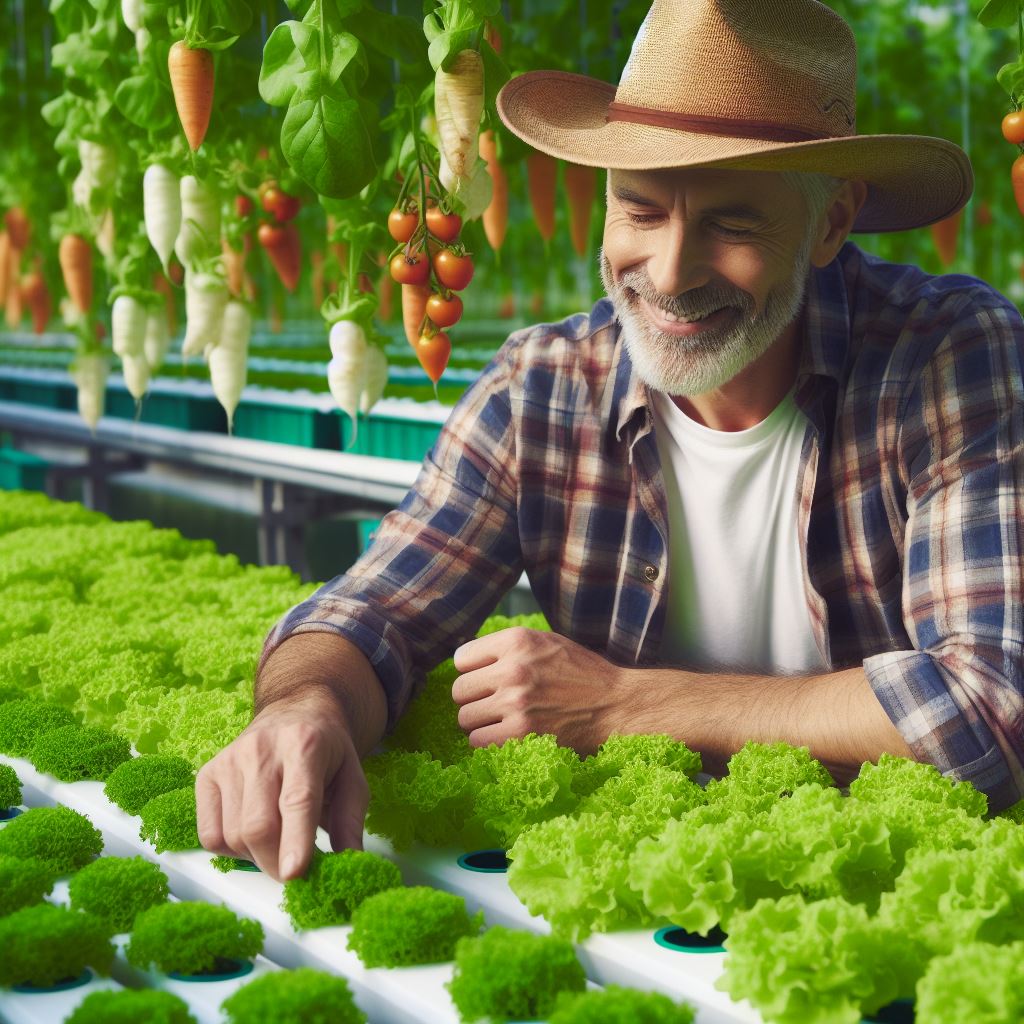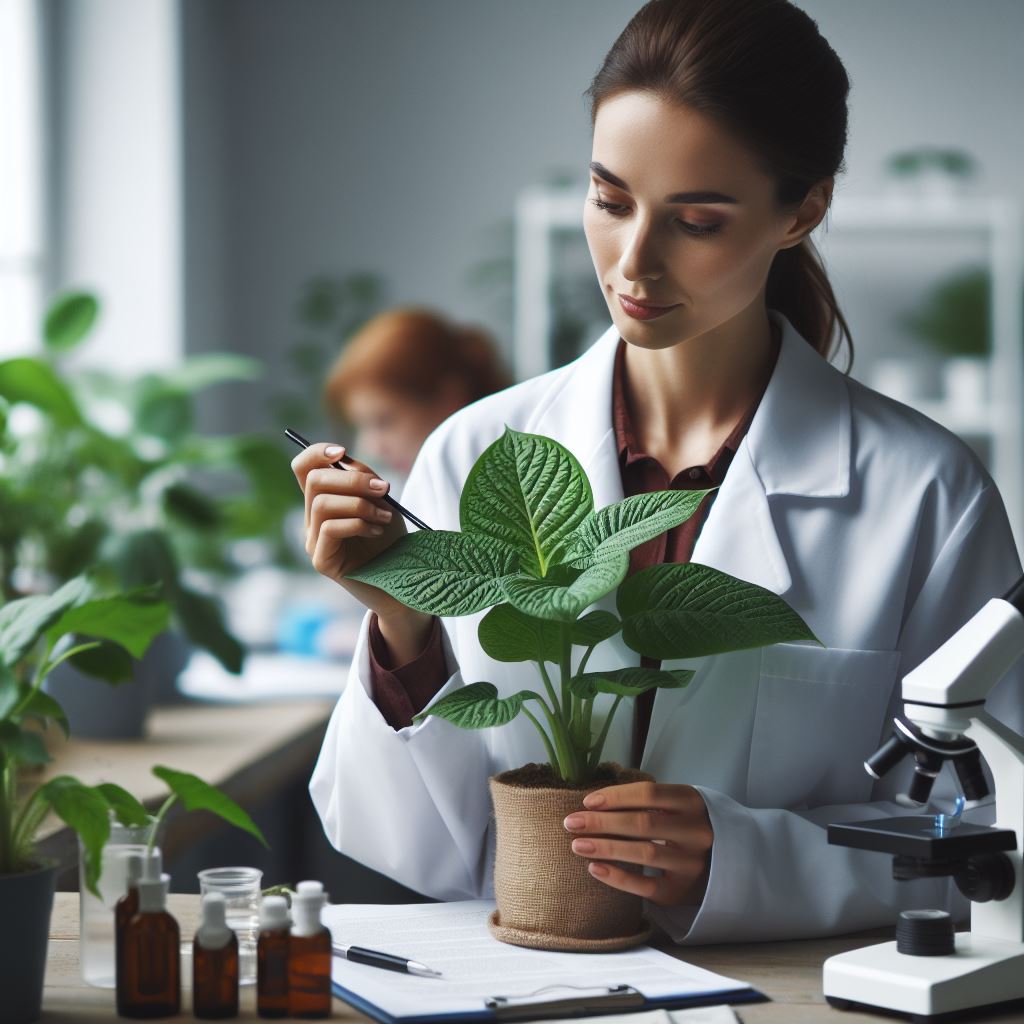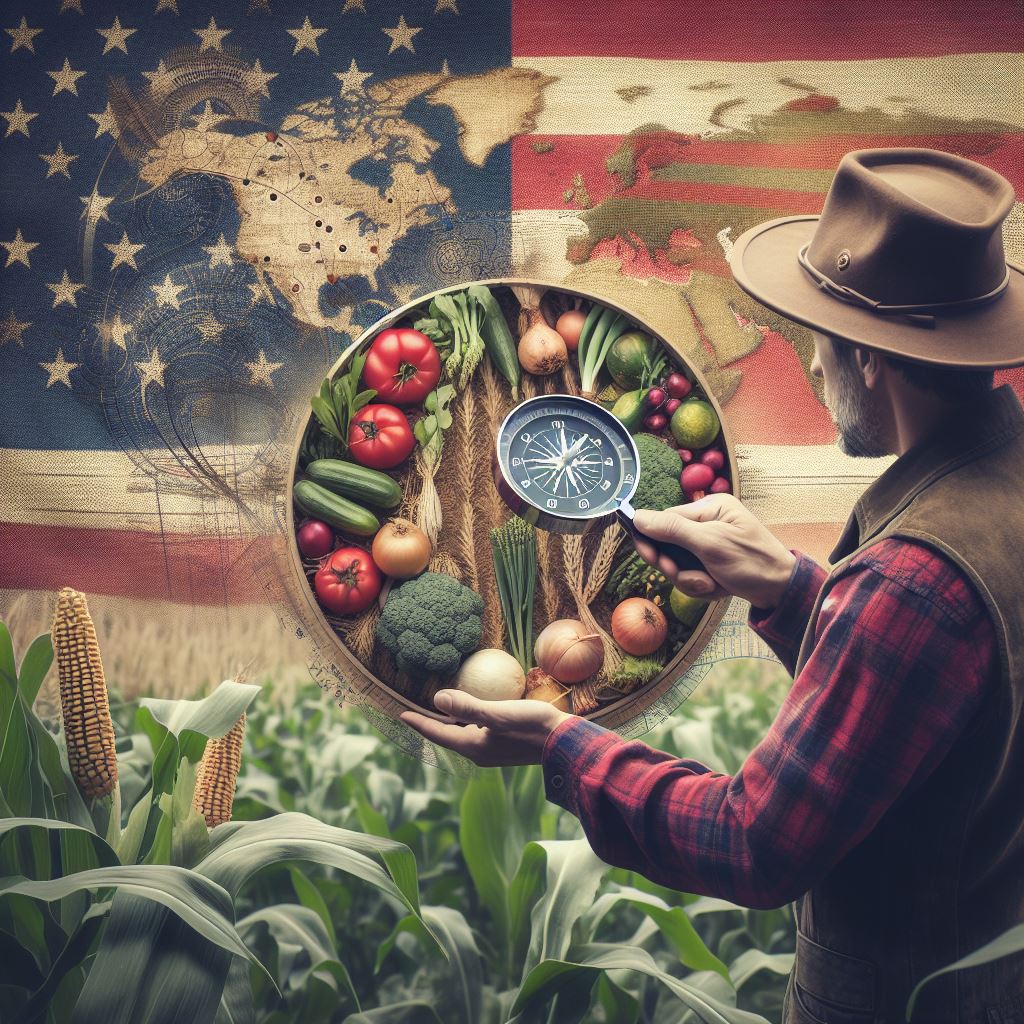Introduction
Hydroponics revolutionizes farming by providing a sustainable and efficient solution for growing plants.
Unlike traditional farming methods that rely on soil, hydroponics involves cultivating plants in water-based nutrient solutions.
One advantage of hydroponics is its ability to conserve water.
The system recirculates the water, reducing water consumption by up to 90% compared to conventional farming.
This is crucial in areas experiencing water scarcity, making hydroponics a viable solution.
Soil erosion is significantly minimized through hydroponics.
Traditional farming methods often contribute to erosion, leading to the loss of fertile topsoil.
With hydroponics, plants are grown in water, eliminating the need for soil.
This helps preserve precious resources and protects the environment.
Another advantage of hydroponics is its ability to maximize crop yield.
By providing plants with optimal nutrient levels, water, and light, hydroponics creates ideal growing conditions.
This results in faster growth and higher yields compared to traditional farming methods.
Hydroponic systems also allow for year-round cultivation, ensuring a consistent food supply regardless of seasonal limitations.
Additionally, hydroponics enables precise control over plant nutrition.
By monitoring nutrient levels and adjusting as needed, growers can optimize plant health and maximize productivity.
Transform Your Agribusiness
Unlock your farm's potential with expert advice tailored to your needs. Get actionable steps that drive real results.
Get StartedThis eliminates the guesswork associated with soil-based farming, leading to healthier, more resilient plants.
Basically, hydroponics offers multiple advantages as a farming revolution.
Its water conservation, prevention of soil erosion, and ability to maximize crop yield make it a sustainable and efficient method.
By embracing hydroponics, we can revolutionize agriculture and secure a more sustainable future.
History of Hydroponics
Origins of hydroponics
Hydroponics, a farming technique that involves growing plants without soil, has a long and intriguing history.
It is believed to have originated in ancient civilizations, where people experimented with growing plants in water.
Historical milestones in hydroponics
- Ancient Babylon: The Hanging Gardens, one of the Seven Wonders of the Ancient World, showcased the early use of hydroponics. Plants were grown in a complex system of terraced gardens using water and channels.
- Aztecs: The Aztecs utilized the chinampas system, floating gardens made of woven reeds, to grow crops using nutrient-rich water from the surrounding lakes.
- Renaissance Europe: In the 17th century, Francis Bacon, an English philosopher, and scientist, conducted experiments on water culture, laying the foundation for modern hydroponics.
- 18th Century: Botanists and scientists, such as Joseph Priestley and Jan Ingenhousz, discovered the role of air and light in plant growth, leading to advancements in hydroponics.
- Late 19th Century: German botanist Julius von Sachs invented the first practical nutrient solution, paving the way for more controlled and efficient hydroponic systems.
- 20th Century: Dr. Gericke, a professor at the University of California, introduced the term “hydroponics” and popularized its use as a modern agricultural technique.
Significance of hydroponics in ancient civilizations
- Mesopotamia: The fertile land between the Tigris and Euphrates rivers faced periodic droughts, motivating the development of hydroponics to ensure reliable crop production.
- Ancient Egypt: The Nile River floodwaters provided essential nutrients for crops, making the Egyptians early pioneers in hydroponics.
- China: The Chinese employed floating gardens to grow vegetables, enabling them to feed large populations with limited arable land.
- Aztec civilization: In their floating gardens, the Aztecs efficiently utilized the wetland environment to sustain agriculture and support their society.
The Role of Hydroponics
Hydroponics played a vital role in these civilizations by overcoming environmental constraints, allowing them to grow crops in otherwise inhospitable conditions.
The knowledge and practices developed by these ancient cultures laid the foundation for modern hydroponics.
As history progressed, hydroponics continued to evolve as a farming method.
Scientists and inventors expanded on earlier findings, improving nutrient solutions, irrigation systems, and artificial lighting.
The ability to control the growth environment became a hallmark of hydroponics.
Today, hydroponics has become widely accepted and practiced globally.
This innovative farming technique offers several advantages, including water conservation, higher crop yields, and the ability to grow produce in urban areas.
Additionally, hydroponics reduces the use of pesticides and allows for year-round cultivation.
The constant advancements in technology and increased understanding of plant physiology have propelled hydroponics to new heights.
Vertical farming, where plants are grown in stacked layers, and aeroponics, which suspends plant roots in air and delivers nutrients through misting, are some of the latest developments in the field.
In the end, the history of hydroponics is a testament to human ingenuity and the desire to find sustainable solutions for food production.
From ancient civilizations to modern times, the development of hydroponics has revolutionized farming practices.
Its significance in providing efficient and sustainable food production cannot be overlooked.
Read: Climate-Smart Crops for Diversification
Key Principles of Hydroponics
Soil-less cultivation
One of the key principles of hydroponics is the ability to grow plants without soil.
This is achieved by using a variety of growing mediums that support the plant’s roots.
By eliminating the need for soil, hydroponics offers numerous advantages over traditional farming methods.
Plants grown hydroponically can be placed closer together, maximizing space and increasing overall crop yield.
Showcase Your Farming Business
Publish your professional farming services profile on our blog for a one-time fee of $200 and reach a dedicated audience of farmers and agribusiness owners.
Publish Your ProfileThis also means that hydroponics can be practiced in areas with poor soil quality or limited land availability.
Nutrient-rich water solutions
In hydroponics, the plants are nourished with a carefully balanced water solution that contains all the necessary nutrients.
This nutrient-rich water supplies everything the plants need to grow and thrive.
The water solution is formulated based on the specific requirements of the plants being cultivated.
By providing the plants with the exact nutrients they need, hydroponics ensures optimum growth and health.
It also allows for better control over plant nutrition, resulting in higher quality and more nutritious produce.
Use of various substrates
Hydroponics allows for the use of different substrates, or growing mediums, to support the plants.
Common substrates include perlite, coconut coir, rockwool, and vermiculite.
These materials provide support for the plant’s roots while allowing for proper water and nutrient absorption.
The choice of substrate depends on factors such as the type of plant being cultivated and the specific hydroponic system being used.
Each substrate has its own unique properties and advantages, allowing for customization and flexibility in hydroponic setups.
Controlled environmental conditions
Another important principle of hydroponics is the ability to maintain precise environmental conditions for optimal plant growth.
Hydroponic systems often include features such as temperature and humidity control, as well as artificial lighting.
This enables growers to create the ideal conditions for their plants, regardless of external factors.
By controlling the environment, hydroponics minimizes the risk of pests, diseases, and weather-related damage.
It also allows for year-round cultivation, independent of seasonal changes that can affect traditional farming methods.
Generally, hydroponics operates based on several key principles, including soil-less cultivation, nutrient-rich water solutions, use of various substrates, and controlled environmental conditions.
By employing these principles, hydroponics revolutionizes farming by enabling efficient and sustainable crop production, even in challenging environments.
With the ability to maximize space, optimize nutrient delivery, and maintain precise environmental conditions, hydroponics offers a promising solution to the world’s growing food demands.
Read: Agri-Tourism: A Growing Income Source
Advantages of Hydroponics in Farming
Efficient water usage and conservation
Hydroponics allows for efficient water usage, as it uses only a fraction of the water traditional farming methods require.
The water in a hydroponic system is recirculated, minimizing wastage and conserving this valuable resource.
By providing the plants with a constant supply of water, hydroponics ensures that they receive optimal hydration without any water loss.
Increased crop yields and shorter growth cycles
Hydroponics facilitates increased crop yields due to its controlled environment and optimized growing conditions.
The plants in a hydroponic system receive the exact amount of nutrients they need, resulting in faster and healthier growth.
With the absence of soil-borne diseases and pests, plants in a hydroponic system grow stronger, leading to higher yields.
Elimination of pests and diseases
One of the significant benefits of hydroponics is the elimination of pests and diseases that often plague traditional farming.
As hydroponics doesn’t use soil, it dramatically reduces the risk of soil-borne pests and diseases.
This eradication of pests and diseases allows plants to thrive without the need for harmful pesticides or chemical treatments.
Optimal nutrient uptake and plant growth
Hydroponics ensures optimal nutrient uptake for plants by directly delivering nutrients to their roots.
The nutrient solution in a hydroponic system is carefully formulated, providing plants with a balanced diet.
Plants in a hydroponic system can absorb nutrients more efficiently, leading to healthier and faster growth.
Suitable for urban and indoor farming
Hydroponics is particularly beneficial for urban and indoor farming, where space and soil quality can be limiting factors.
As hydroponics doesn’t require large plots of land, it is an ideal option in urban areas with limited space.
Its indoor farming applications allow for year-round cultivation, regardless of external climate conditions.
In short, hydroponics offers several advantages over traditional farming methods.
Its efficient water usage and conservation, increased crop yields, and elimination of pests and diseases make it a revolutionary approach to farming.
Additionally, optimal nutrient uptake and suitability for urban and indoor farming further contribute to its appeal.
With these benefits, hydroponics has the potential to transform the agricultural industry and provide sustainable solutions for food production in the future.
Read: Data-Driven Farming: Key to Agri Success
Showcase Your Farming Business
Publish your professional farming services profile on our blog for a one-time fee of $200 and reach a dedicated audience of farmers and agribusiness owners.
Publish Your ProfileDifferent Hydroponic Systems
Nutrient Film Technique (NFT)
The Nutrient Film Technique (NFT) is a popular hydroponic system that uses a thin film of nutrient-rich water to continuously flow over the roots of the plants.
This system is a dynamic and simple way to grow plants without soil.
The NFT system works by pumping nutrient-rich water into a sloping tray, creating a shallow film of water.
The plants are placed in small pots or troughs with their roots dipping into the flowing water.
The excess water is collected at the end of the tray and reused.
One advantage of the NFT system is its efficiency in water and nutrient usage.
The continuous flow of water ensures that the roots receive an adequate supply of oxygen and nutrients.
It also prevents water stagnation, reducing the risk of root diseases.
Deep Water Culture (DWC)
Deep Water Culture (DWC), also known as the floating raft system, is another popular hydroponic method.
In this system, the plants are suspended in a nutrient solution with their roots directly immersed in the water.
The plants are placed in net pots filled with a growing medium such as expanded clay pellets or rockwool.
The roots hang freely in the nutrient solution, allowing for maximum oxygen absorption.
Air stones or diffusers are used to ensure a constant supply of oxygen to the roots.
DWC is a simple and effective hydroponic system, perfect for growing leafy greens and herbs.
It requires minimal maintenance and offers excellent nutrient uptake and plant growth.
However, monitoring water temperature and oxygen levels is crucial to avoid root rot.
Ebb and Flow (Flood and Drain)
The Ebb and Flow system, also known as Flood and Drain, involves periodically flooding the growing tray with nutrient solution and then draining it back into the reservoir.
This cycle is controlled by a timer or a sensor.
During the flooding phase, the roots are submerged in nutrient-rich water, absorbing the required nutrients and oxygen.
When the timer turns off, the water drains back into the reservoir, allowing the roots to breathe and preventing waterlogging.
Ebb and Flow systems are versatile and suitable for a wide range of plants.
They are relatively easy to set up and can be automated. However, regular monitoring of water levels and nutrient concentrations is essential for optimal plant growth.
Aeroponics
Aeroponics is a high-tech hydroponic system that involves growing plants in an air or mist environment without the use of a growing medium.
Instead, the plants are suspended, and their roots are misted with a nutrient solution.
Aeroponics provides exceptional oxygenation to the roots, promoting rapid growth and high yields.
The misted nutrient solution is delivered through misting nozzles or ultrasonic devices, ensuring optimal nutrient absorption.
This system requires precise control over environmental factors such as temperature, humidity, and nutrient concentration.
It is commonly used for growing fragile and high-value crops, but its complexity and cost make it less suitable for beginners.
Drip System
The Drip System is one of the most widely used hydroponic systems, known for its simplicity and versatility.
It involves dripping a nutrient solution directly onto the base of the plants through a network of drip lines.
The nutrient solution is pumped from a reservoir and delivered to each plant individually.
Excess solution drips down and can be collected for reuse. Drip systems allow for precise control over nutrient delivery, reducing waste.
Drip systems are suitable for a variety of plants and are easily customizable.
They are relatively low-cost and require minimal maintenance, making them ideal for both home gardeners and commercial growers.
Essentially, there are several different hydroponic systems available, each with its own advantages and suitability for specific types of plants.
Whether you choose the Nutrient Film Technique, Deep Water Culture, Ebb and Flow, Aeroponics, or Drip System, hydroponics offers an innovative and efficient way to revolutionize farming.
Read: Robotics in Farming: The Future of Agri-Tech

Examples of Successful Hydroponic Farms
Major hydroponic farms worldwide
- Green Sense Farms in Indiana, USA holds the title of the largest indoor vertical hydroponic farm.
- Thanet Earth in the UK is one of the largest greenhouse complexes, utilizing hydroponics to grow a variety of crops.
- AeroFarms in New Jersey, USA is a vertical farming company that grows leafy greens and herbs in an indoor environment using hydroponics.
Success stories and innovative approaches
- Gotham Greens in Brooklyn, USA successfully operates rooftop greenhouses, growing fresh produce using hydroponics.
- Plantagon in Sweden showcases an innovative approach with their vertical greenhouse and urban farm.
- The Growcer in Canada provides turnkey hydroponic systems and has helped numerous communities grow fresh food in earlier non-arable regions.
Real-life examples of hydroponics in different climates
- Rooftop Republic in Hong Kong is utilizing hydroponics to grow fresh produce in an urban environment with limited space.
- Desert Green Technologies in Dubai, UAE showcases how hydroponics can be used to grow crops in arid desert conditions.
- Sky Greens in Singapore operates vertical hydroponic farms, making use of the limited land available in the city-state.
Hydroponic farms have gained significant attention and success worldwide, demonstrating the potential for sustainable agriculture without relying on conventional soil-based farming methods.
Major hydroponic farms worldwide
Major hydroponic farms can be found globally, showcasing the scalability and effectiveness of this innovative farming technique.
Green Sense Farms in Indiana, USA holds the record for the largest indoor vertical hydroponic farm, demonstrating the ability to maximize space while growing a wide range of crops.
Showcase Your Farming Business
Publish your professional farming services profile on our blog for a one-time fee of $200 and reach a dedicated audience of farmers and agribusiness owners.
Publish Your ProfileThanet Earth in the UK is another notable example, comprising a vast greenhouse complex that utilizes hydroponics to cultivate various fruits and vegetables.
By controlling environmental conditions, these farms achieve higher yields and optimize resource usage.
AeroFarms in New Jersey, USA, stands out for its vertical farming approach, cultivating leafy greens and herbs in indoor environments using hydroponics.
The vertical setup maximizes available space and enables year-round production, reducing the need for external land and minimizing transportation costs.
Success stories and innovative approaches
Beyond large-scale hydroponic farms, there are also success stories and innovative approaches by smaller operations.
Gotham Greens, located in Brooklyn, USA, grows fresh produce on urban rooftops.
By employing hydroponics, they are able to capitalize on unused space and provide locally grown, high-quality food to their community.
Plantagon in Sweden has developed a vertical greenhouse and urban farm concept, allowing for efficient cultivation in urban areas.
This innovative approach not only addresses the issue of limited space but also promotes sustainability and shorter supply chains.
The Growcer in Canada offers turnkey hydroponic systems that have been successfully implemented in various communities.
By providing the necessary equipment and expertise,
The Growcer enables communities to grow fresh food in regions previously unsuitable for agriculture.
Real-life examples of hydroponics in different climates
Hydroponics is not limited to specific climates either.
Rooftop Republic in Hong Kong has taken advantage of hydroponics to grow fresh produce in urban areas with limited space.
This initiative aims to provide locally sourced food and promote sustainability within cities.
Desert Green Technologies in Dubai, UAE, illustrates how hydroponics can be used in arid desert conditions.
By controlling water and nutrient delivery directly to the plants’ roots, crops can thrive in regions once considered unsuitable for traditional farming.
Singapore’s Sky Greens operates vertical hydroponic farms, utilizing the limited land available in the densely populated city-state.
By growing food vertically, Sky Greens maximizes land use and reduces the environmental footprint associated with food production.
These real-life examples showcase the versatility and applicability of hydroponics in various climates and environments.
The success of hydroponic farming demonstrates its potential to revolutionize agriculture and provide sustainable solutions for food production in the future.
Gain More Insights: Agri-Tech: Revolutionizing Crop Management
Challenges and Limitations of Hydroponics
Initial setup costs
- Hydroponics often requires expensive equipment and materials for its initial setup.
- The cost of purchasing nutrient solutions, grow lights, pumps, and other necessary components can be quite high.
- For small-scale farmers or individuals, these costs may pose a significant financial challenge.
Technical knowledge and skill requirements
- Successful hydroponic farming requires a good understanding of plant biology, chemistry, and water management.
- Growers need to have the technical expertise to monitor and adjust nutrient levels in the water.
- They must also be skilled in pest and disease management, as the controlled environment of hydroponics may still attract pests.
Dependence on reliable power and water supply
- Hydroponic systems heavily rely on a consistent and uninterrupted supply of electricity and water.
- Power outages or water shortages can disrupt the system, leading to crop damage or even complete loss.
- In areas with unreliable infrastructure, hydroponic farming may not be a feasible option.
Limited crop variety compared to traditional farming
- Hydroponics is more suitable for growing certain crops, such as leafy greens, herbs, and tomatoes.
- Plants that require large root systems or have extensive vine growth may not thrive in hydroponic systems.
- Fruit trees and grains, which are staples of traditional farming, pose challenges in hydroponics due to their structural requirements.
Despite its numerous advantages, hydroponics faces several challenges and limitations that need to be addressed.
The initial setup costs can be prohibitive, making it difficult for small-scale farmers or individuals to adopt this method.
Additionally, hydroponic farming requires specialized technical knowledge and skills, such as understanding plant biology and water management.
Pest and disease management also play a crucial role in ensuring successful crop growth in a controlled environment.
Furthermore, hydroponics heavily relies on a reliable power supply and water source, making it vulnerable to disruptions due to power outages or water shortages.
In areas with unreliable infrastructure, traditional farming may be a more practical option.
Finally, the limited crop variety is another limitation of hydroponics.
Certain crops, such as leafy greens, herbs, and tomatoes, thrive in hydroponic systems, but larger plants with extensive root systems or vine growth may not be suitable.
Staple crops like fruit trees and grains also present structural challenges in a hydroponic setup.
How to overcome these challenges
To overcome these challenges, ongoing research and development in hydroponic technology are crucial.
Finding cost-effective solutions, simplifying technical aspects, and expanding crop diversity in hydroponics are areas that require further exploration.
Continued improvements in energy efficiency and the development of alternative power sources can reduce the dependence on a reliable electricity supply.
Additionally, advancements in water management techniques, such as recycling and desalination, can address water scarcity issues.
Collaboration between scientists, farmers, and policymakers is essential to overcome these limitations and unlock the full potential of hydroponics.
By addressing these challenges, hydroponics can truly revolutionize the way we farm and contribute to a sustainable and food-secure future.
Future Implications and Potential
Integration of technology in hydroponics
Hydroponics, coupled with advanced technologies, has the potential to revolutionize farming practices.
Incorporating automation and artificial intelligence can enhance crop management and optimize resource utilization.
Intelligent sensors can monitor essential plant parameters and regulate nutrient delivery in real-time, promoting optimal growth.
By integrating technology, hydroponics can ensure precise control over environmental factors, resulting in higher yields and better crop quality.
Showcase Your Farming Business
Publish your professional farming services profile on our blog for a one-time fee of $200 and reach a dedicated audience of farmers and agribusiness owners.
Publish Your ProfileSustainable farming and environmental benefits
Hydroponics offers numerous environmental advantages over traditional agriculture methods.
By eliminating the need for soil, it reduces land degradation and soil erosion.
Controlled nutrient solutions prevent excessive fertilizer use, thus minimizing water pollution.
With efficient water management systems, hydroponics uses up to 90% less water compared to conventional farming.
By eliminating the need for pesticides, it reduces chemical contamination in food and soil, leading to healthier ecosystems.
Potential for addressing food insecurity and urban agriculture
Hydroponics presents a promising solution for global food insecurity and urban agriculture challenges.
With its ability to grow crops in limited spaces, it can be implemented in densely populated urban areas.
Vertical farming systems maximize land utilization, allowing for higher crop yields per square meter.
Since hydroponics does not rely on fertile soil, it can be established anywhere, providing communities with fresh produce.
By reducing transportation costs and carbon emissions associated with long-distance food supply chains, it improves food accessibility.
Collaboration and research opportunities
The future of hydroponics relies on cooperation between researchers, agronomists, and technology experts.
Efforts to develop innovative hydroponic systems and improve existing technologies require multidisciplinary collaborations.
Partnerships between academic institutions, government agencies, and private industries can accelerate advancements in this field.
Research opportunities can involve optimizing nutrient solutions, designing energy-efficient systems, and exploring novel plant varieties.
The collaboration between different stakeholders will contribute to the continued growth and development of hydroponics.
In essence, the integration of technology enables hydroponics to offer sustainable and innovative solutions for farming.
Its potential includes improved resource utilization, minimized environmental impact, and increased food production.
By addressing food insecurity, urban agriculture, and promoting research collaborations, hydroponics can revolutionize the future of farming.
With further advancements and widespread adoption, hydroponics has the potential to transform agriculture and contribute to a more sustainable and food-secure world.
Conclusion
Recap and summary of key points
In this blog post, we explored the revolutionary impact of hydroponics in farming.
Through hydroponics, plants can grow without the need for soil, utilizing nutrient-rich water solutions instead.
This method allows for year-round cultivation, increased crop yields, and reduced water usage.
Additionally, hydroponics eliminates the risk of soil-borne diseases and pests, leading to healthier plants and safer food production.
The controlled environment also allows for precise control over nutrient levels, pH, and light exposure, optimizing plant growth and minimizing waste.
We discussed the different types of hydroponic systems, including nutrient film technique, deep water culture, and aeroponics.
Each system has its own advantages and can be tailored to suit specific plant types and growing conditions.
Final thoughts on the revolutionary impact of hydroponics in farming
Undoubtedly, hydroponics has the potential to revolutionize the agricultural industry.
By overcoming the limitations of traditional farming, hydroponics offers a sustainable solution for increasing food production and ensuring food security in a rapidly growing population.
Moreover, hydroponics can be implemented in various settings, including urban areas, where land availability is limited.
This opens up new possibilities for local and vertical farming, bringing fresh produce closer to consumers and reducing transportation costs.
While there are challenges to overcome, such as initial investment costs and technical expertise required, the benefits of hydroponics far outweigh the drawbacks.
With advancements in technology and increasing awareness of sustainable farming practices, we can expect to see widespread adoption of hydroponics in the near future.
In a nutshell, hydroponics is a game-changer in the world of agriculture.
It offers a more efficient and sustainable approach to farming, ensuring food security and minimizing environmental impact.
Embracing this revolution in farming will pave the way for a brighter, greener future.




